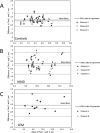Reliability of the triple-timed up-and-go test
- PMID: 28545168
- PMCID: PMC5702274
- DOI: 10.1002/mus.25700
Reliability of the triple-timed up-and-go test
Abstract
Introduction: We report the reliability of a new measure, the triple-timed up-and-go (3TUG) test, for assessing clinical function in patients with Lambert-Eaton myasthenia (LEM).
Methods: Intrarater reproducibility and interrater agreement of the 3TUG test were assessed in 25 control participants, 24 patients with non-LEM neuromuscular disease, and 12 patients with LEM. The coverage probability (CP) method was the primary measure of reproducibility and agreement. The a priori acceptable range was < 20% difference in 3TUG test times and a CP ≥0.90 confirmed agreement.
Results: CP values > 0.90 for intrarater and interrater tests confirmed acceptable reproducibility and agreement for all groups.
Discussion: The 3TUG test is a quick, noninvasive, and reproducible measure that is easy to perform, measures clinically important weakness in LEM patients, and requires little training. Additional evaluation in a larger number of LEM patients is in progress to validate the 3TUG test as a clinical measure in LEM. Muscle Nerve 57: 136-139, 2017.
Keywords: 3,4-diaminopyridine; Lambert-Eaton myasthenia; coverage probability; outcome measures; reliability; timed up-and-go test.
© 2017 Wiley Periodicals, Inc.
Conflict of interest statement
The remaining authors have no conflict of interest to disclose.
Figures

References
-
- Bischoff HA, Stahelin HB, Monsch AU, Iversend MD, Weyh A, von Dechend M, Akos R, Conzelmann M, Dick W, Theiler R. Identifying a cut-off point for normal mobility: a comparison of the timed "up and go" test in community-dwelling and institutionalised elderly women. Age Aging. 2003;32:315–320. - PubMed
-
- Morris S, Morris ME, Iansek R. Reliability of measurements obtained with the timed "up & go" test in people with Parkinson Disease. Phys Ther. 2001;81:810–818. - PubMed
-
- Steffen TM, Hacker TA, Mollinger L. Age- and gender-related test performance in community-dwelling elderly people: six-minute walk test, Berg balance scale, timed up & go test and gait speeds. Phys Ther. 2002;82:128–137. - PubMed
-
- Huang SL, Hsieh C-L, Wu R-M, Tai C-H, Lin C-H, Lu W-S. Minimal detectable change of the timed "up & go" test and the dynamic gait index in people with Parkinson Disease. Phys Ther. 2011;91:114–121. - PubMed
-
- Ries JD, Echternach JL, Nof L, Blodgett MG. Test-retest reliability and minimal detectable change scores for the timed "up & go" test, the six minute walk test, and gait speed in people with Alzheimer disease. Phys Ther. 2009;89:569–579. - PubMed
MeSH terms
Grants and funding
LinkOut - more resources
Full Text Sources
Other Literature Sources
Miscellaneous

